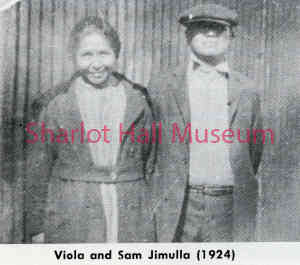By Karen Kamradt
Eighty-eight years ago on May 9, 1935, Sam Jimulla (pronounced gee-mew-lah’) was appointed Chief of the Prescott Yavapai by the U.S. Commissioner of Indian Affairs, John Collier (1933-1945). At the same time, Sam was officially elected by his people to be their leader and Chief.

The history of the Yavapai began centuries ago when they lived as hunters, gatherers and basket weavers in an area covering more than nine million acres (known today as central and western Arizona). Prior to the 1860s, Yavapai homelands supported several thousand members of the Tribe. Granite Mountain was known to be their ancestral home. Although there were four divisions of Yavapai, they considered themselves one people who spoke the same language and shared the same beliefs and customs. In the early to mid-1800s, miners and settlers began moving into the area, and the lifestyles of the Yavapai people were dramatically altered.
By the 1870s, several attempts had been initiated by the U.S. Government to relocate the four groups of Yavapai onto reservations. In 1875 the Yavapai were forcibly marched to the San Carlos Apache Indian Reservation located in the eastern part of the Arizona Territory. The March of Tears, as the Yavapai call it, began their approximately 25 year confinement at San Carlos. When Native Americans were first permitted to leave the reservations in the 1900s, a few Yavapai families settled in the Prescott area, while others relocated to Middle Verde and Fort McDowell. Some remained at San Carlos. Historians estimate that the entire Yavapai Tribe had been reduced to fewer than 600 individuals.
 On the San Carlos Indian Reservation circa 1877, Sam “Red Ants” Jimulla was born. Also born at San Carlos in June of 1878, was Viola “Born Quickly” Sica-tuva. They didn’t know each other until they met at a Fourth of July celebration in Prescott. Viola was walking from the train station to the plaza and saw a group of young men sitting and talking–Sam was one of them. Later, when asked about meeting Viola for the first time, Sam said, “I thought she was a kindhearted and very generous person - and I liked that.” Sam and Viola were married in 1901 in a tribal ceremony and eventually moved to the Prescott area with several other Yavapai families. They had five daughters: Daisy (1902-1902), Grace (Mrs. Don) Mitchell (1903-1976), Lucy (Mrs. Jim) Miller (1906-1984), Amy Vaughn Gazzam (1912-1940), and Rosie (1913-1914).
On the San Carlos Indian Reservation circa 1877, Sam “Red Ants” Jimulla was born. Also born at San Carlos in June of 1878, was Viola “Born Quickly” Sica-tuva. They didn’t know each other until they met at a Fourth of July celebration in Prescott. Viola was walking from the train station to the plaza and saw a group of young men sitting and talking–Sam was one of them. Later, when asked about meeting Viola for the first time, Sam said, “I thought she was a kindhearted and very generous person - and I liked that.” Sam and Viola were married in 1901 in a tribal ceremony and eventually moved to the Prescott area with several other Yavapai families. They had five daughters: Daisy (1902-1902), Grace (Mrs. Don) Mitchell (1903-1976), Lucy (Mrs. Jim) Miller (1906-1984), Amy Vaughn Gazzam (1912-1940), and Rosie (1913-1914).
The Jimullas became active members in 1922 of the Yavapai Indian Mission, which was established in the Prescott area around 1872. It was a small one-room mission that eventually became the Yavapai Indian Presbyterian Church. Sam and Viola were appointed interpreters, teachers and Elders of the church, guiding and encouraging education among its Yavapai members. At this time, only the Yavapai dialect of the Yuman tongue was spoken at the mission.
 During the Fall of 1933, the Yavapai received aid from the Civil Works Administration (CWA) in the form of Project P43, which built houses and improved living conditions for many families in the Camp Yavapai area. The houses and Tribal council building were built of waterworn stone, native granite and concrete. Sam Jimulla, known to be a natural leader, was put in charge of the Indian work crews.To ensure that other families were housed first, Sam saved construction of his home for last. However, in the spring of 1934, project funding ran out while construction of the Jimulla’s house was in the beginning stages. With help from neighbors’ contributions and manpower, their family home was finally completed by the end of the year.
During the Fall of 1933, the Yavapai received aid from the Civil Works Administration (CWA) in the form of Project P43, which built houses and improved living conditions for many families in the Camp Yavapai area. The houses and Tribal council building were built of waterworn stone, native granite and concrete. Sam Jimulla, known to be a natural leader, was put in charge of the Indian work crews.To ensure that other families were housed first, Sam saved construction of his home for last. However, in the spring of 1934, project funding ran out while construction of the Jimulla’s house was in the beginning stages. With help from neighbors’ contributions and manpower, their family home was finally completed by the end of the year.
To be continued in two weeks on 7/16/2023.
To learn more about the Yavapai People, visit the exhibit “The Baskets Keep Talking” at the Sharlot Hall Museum or contact the Yavapai-Prescott Indian Tribe Culture Research Department (928) 515-7202.
“Days Past” is a collaborative project of the Sharlot Hall Museum and the Prescott Corral of Westerners International (www.prescottcorral.org). This and other Days Past articles are also available at www.archives.sharlothallmuseum.org/articles/days-past-articles/1 The public is encouraged to submit proposed articles and inquiries to dayspast@sharlothallmuseum.org Please contact SHM Research Center reference desk at 928-277-2003, or via email at archivesrequest@sharlothallmuseum.org for information or assistance with photo requests.


